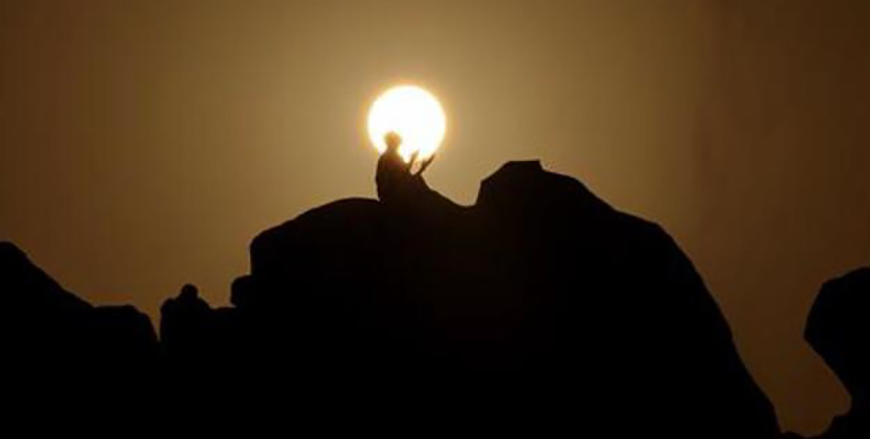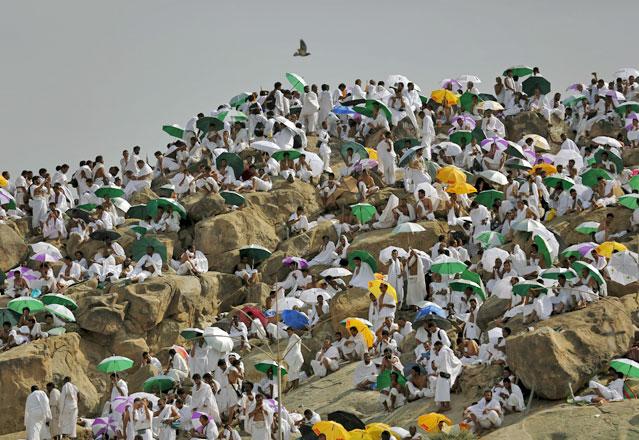You are here
Muslim pilgrims pray atop scorching Mount Arafat in Hajj climax
By AFP - Jun 15,2024 - Last updated at Jun 15,2024

This aerial view shows Mount Arafat, also known as Jabal Al-Rahma or Mount of Mercy, surrounded by tents used by pilgrims during the climax of the Hajj pilgrimage on June 15, 2024. More than 1.5 million Muslims will pray on Mount Arafat in soaring temperatures on June 15, in the high-point and most gruelling day of the annual Hajj pilgrimage, one of the five pillars of Islam that must be performed at least once by all Muslims who have the means to do so (AFP Photo)
MOUNT ARAFAT, Mecca — Vast crowds of Muslims gathered for hours under the hot sun atop Mount Arafat Saturday for the high point of the annual Hajj pilgrimage, offering prayers including for Palestinians in war-ravaged Gaza.
Clad in white, worshippers began arriving at dawn for the most gruelling day of the annual rites, climbing the rocky, 70-metre (230-foot) hill where the Prophet Mohammed is believed to have given his last sermon.
The temperature on Mount Arafat hit 46 degrees Celsius, the spokesman for the national meteorology centre said on X, creating taxing conditions for pilgrims who had spent the night in a giant tented city in Mina, a valley outside Mecca, Islam's holiest city.
"This is the most important day," said 46-year-old Egyptian Mohammed Asser, who came prepared with a list of prayers. "I pray also for the Palestinians. May God help them."
Some 1.8 million pilgrims have participated in this year's Hajj, the state-affiliated Al-Ekhbariya channel reported on Saturday, roughly the same as last year's total.
This year the pilgrimage has unfolded in the shadow of the Israeli war on Gaza, which has killed at least 37,266 people in the Strip, mostly civilians, according to the territory's health ministry.
Some 2,000 Palestinians are performing the Hajj at the special invitation of Saudi King Salman, official media said.
The Hajj, one of the world's biggest religious gatherings, is increasingly affected by climate change, according to a Saudi study published last month that said regional temperatures were rising 0.4 degrees Celsius each decade.
Saudi authorities have urged pilgrims to drink plenty of water and protect themselves from the sun during the rituals, which take at least five days to complete and are mostly outdoors. Since men are prohibited from wearing hats, many carry umbrellas.
Mustafa, an Algerian pilgrim who gave only his first name, clung to his umbrella which was handed out by Hajj organisers, saying, "it's what saves you here".
Another man, an Egyptian who preferred to remain anonymous, said he was drinking "a lot of juice and water" and had twice stopped to rest on the roadside.
More than 10,000 heat-related illnesses were recorded last year, 10 percent of them heat stroke, a Saudi official told AFP this week.
Ahmad Karim Abdelsalam, a 33-year-old pilgrim from India, admitted that he found the prospect of praying atop Mount Arafat "a little scary".
But with the help of an umbrella and water sprays, "God willing, everything will go well", he said.
'Once in a lifetime'
The hajj is one of the five pillars of Islam and all Muslims with the means must perform it at least once.
Yet visas, doled out to individual countries on a quota system, can be difficult to obtain.
"It's a chance that only comes once in a lifetime, I couldn't not come," said Abdulrahman Siyam, a 55-year-old Iraqi pilgrim who was performing the rituals on a prosthetic leg.
After Mount Arafat, the pilgrims will head to Muzdalifah, where they will collect pebbles to carry out the symbolic "stoning of the devil" ritual in Mina on Sunday.
The Hajj is said to follow the path of the Prophet Mohammed's final pilgrimage, about 1,400 years ago.
Related Articles
Mount Arafat, Saudi Arabia — More than 1.5 million Muslims will pray on Mount Arafat in soaring temperatures on Saturday, in the high-point
MINA, Saudi Arabia - Vast crowds of worshippers hurled pebbles in the "stoning of the devil" ritual on Wednesday as the biggest Hajj pilgrim
MOUNT ARAFAT, Saudi Arabia — Around two million Muslims on Wednesday poured into the vast Saudi plain where Prophet Mohammad is believed to


















